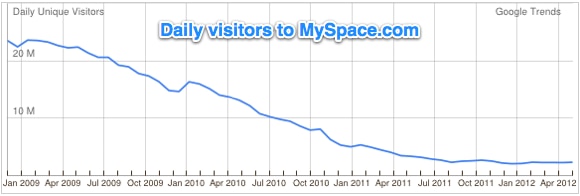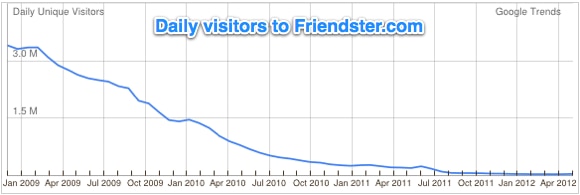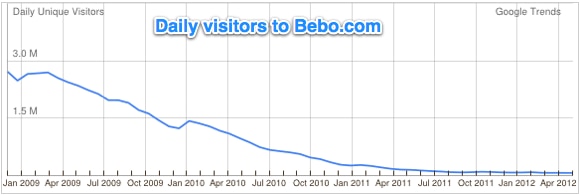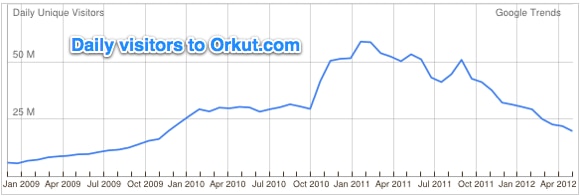
Once users start abandoning a social network, like migrating birds, they leave in droves. Unlike birds, however, they don’t come back.
Case in point, the MySpace traffic graph at the top. In just three years, the former social network giant has gone from having north of 20 million daily visitors to around 2 million. In other words, the MySpace website has lost more than 90% of its visitors in that time.
To further illustrate this phenomenon, here are the traffic changes for three other formerly popular social networks from yesteryear.
The decline of Friendster
In three years, Friendster has gone from over 3 million daily visitors to around 40k. That’s almost a 99% drop in visitors.

Friendster more or less threw in the social networking towel last summer, when it decided to become a social gaming site. Judging by site traffic alone, it hasn’t gone too well.
The decline of Bebo
In three years, Bebo has gone from just under 3 million daily visitors to around 50k, roughly a 98% loss.

AOL bought Bebo for $850 million in 2008 and reportedly sold it for under $10 million in 2010. Not the company’s best investment.
The decline of Orkut
Early in 2011, Orkut’s website had nearly 60 million daily visitors. Today that number has dropped to less than 20 million. That’s roughly a 66% loss (two thirds) in little over a year.

Google’s original social network is far from dead, but it’s clear that it’s peaked and is now on its way down. Even in its strongest market, Brazil, Orkut is losing out to Facebook.
A social swan song
To risk another analogy, watching the decline in visitor numbers to these sites is like watching a long line of lemmings walk resolutely off a sheer cliff. It’s a quick and merciless exodus.
It must be a frustrating experience for the people behind these social networks, considering all the hard work that’s gone into the creation and maintenance of these sites.
Seeing this, one has to wonder which social network will be the next one on the slippery downward slope.
Data source: Traffic numbers and charts are from Google Trends for Websites, and are estimates for worldwide traffic (daily unique visitors).
























